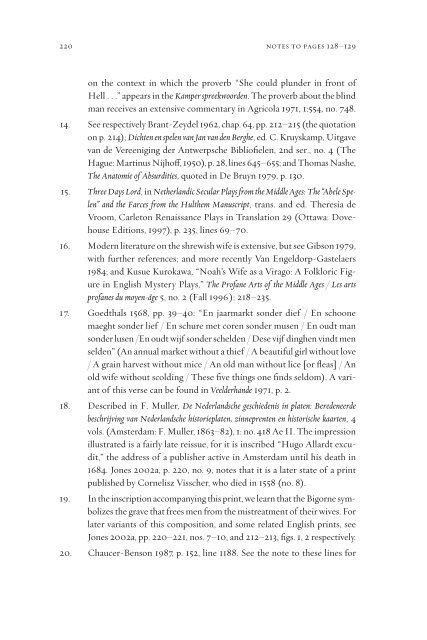Pieter Bruegel and the Art of Laughter - AAAARG.ORG
Pieter Bruegel and the Art of Laughter - AAAARG.ORG
Pieter Bruegel and the Art of Laughter - AAAARG.ORG
Create successful ePaper yourself
Turn your PDF publications into a flip-book with our unique Google optimized e-Paper software.
220 notes to pages 128–129<br />
on <strong>the</strong> context in which <strong>the</strong> proverb “She could plunder in front <strong>of</strong><br />
Hell . . .” appears in <strong>the</strong> Kamper spreekwoorden. The proverb about <strong>the</strong> blind<br />
man receives an extensive commentary in Agricola 1971, 1:554, no. 748.<br />
14. See respectively Brant-Zeydel 1962, chap. 64, pp. 212–215 (<strong>the</strong> quotation<br />
on p. 214); Dichten en spelen van Jan van den Berghe, ed. C. Kruyskamp, Uitgave<br />
van de Vereeniging der Antwerpsche Bibli<strong>of</strong>ielen, 2nd ser., no. 4 (The<br />
Hague: Martinus Nijhoª, 1950), p. 28, lines 645–655; <strong>and</strong> Thomas Nashe,<br />
The Anatomie <strong>of</strong> Absurdities, quoted in De Bruyn 1979, p. 130.<br />
15. Three Days Lord, in Ne<strong>the</strong>rl<strong>and</strong>ic Secular Plays from <strong>the</strong> Middle Ages: The “Abele Spelen”<br />
<strong>and</strong> <strong>the</strong> Farces from <strong>the</strong> Hul<strong>the</strong>m Manuscript, trans. <strong>and</strong> ed. Theresia de<br />
Vroom, Carleton Renaissance Plays in Translation 29 (Ottawa: Dovehouse<br />
Editions, 1997), p. 235, lines 69–70.<br />
16. Modern literature on <strong>the</strong> shrewish wife is extensive, but see Gibson 1979,<br />
with fur<strong>the</strong>r references; <strong>and</strong> more recently Van Engeldorp-Gastelaers<br />
1984; <strong>and</strong> Kusue Kurokawa, “Noah’s Wife as a Virago: A Folkloric Figure<br />
in English Mystery Plays,” The Pr<strong>of</strong>ane <strong>Art</strong>s <strong>of</strong> <strong>the</strong> Middle Ages / Les arts<br />
pr<strong>of</strong>anes du moyen-âge 5, no. 2 (Fall 1996 ): 218–235.<br />
17. Goedthals 1568, pp. 39–40: “En jaarmarkt sonder dief / En schoone<br />
maeght sonder lief / En schure met coren sonder musen / En oudt man<br />
sonder lusen /En oudt wijf sonder schelden / Dese vijf dinghen vindt men<br />
selden” (An annual market without a thief / A beautiful girl without love<br />
/ A grain harvest without mice / An old man without lice [or fleas] / An<br />
old wife without scolding / These five things one finds seldom). A variant<br />
<strong>of</strong> this verse can be found in Veelderh<strong>and</strong>e 1971, p. 2.<br />
18. Described in F. Muller, De Nederl<strong>and</strong>sche geschiedenis in platen: Beredeneerde<br />
beschrijving van Nederl<strong>and</strong>sche historieplaten, zinneprenten en historische kaarten, 4<br />
vols. (Amsterdam: F. Muller, 1863–82), 1: no. 418 Ae II. The impression<br />
illustrated is a fairly late reissue, for it is inscribed “Hugo Allardt excudit,”<br />
<strong>the</strong> address <strong>of</strong> a publisher active in Amsterdam until his death in<br />
1684. Jones 2002a, p. 220, no. 9, notes that it is a later state <strong>of</strong> a print<br />
published by Cornelisz Visscher, who died in 1558 (no. 8).<br />
19. In <strong>the</strong> inscription accompanying this print, we learn that <strong>the</strong> Bigorne symbolizes<br />
<strong>the</strong> grave that frees men from <strong>the</strong> mistreatment <strong>of</strong> <strong>the</strong>ir wives. For<br />
later variants <strong>of</strong> this composition, <strong>and</strong> some related English prints, see<br />
Jones 2002a, pp. 220–221, nos. 7–10, <strong>and</strong> 212–213, figs. 1, 2 respectively.<br />
20. Chaucer-Benson 1987, p. 152, line 1188. See <strong>the</strong> note to <strong>the</strong>se lines for












